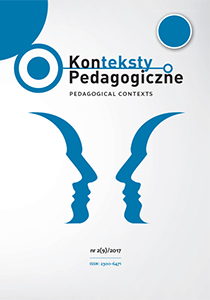Abstract
The paper aims to define a workable model of good pedagogy for the purpose of evaluation of university teaching based on student ratings. Firstly, it reviews definitions of effective teaching and ways of measuring it. Then, the model of good pedagogy selected for its suitability for evaluation by university student ratings is introduced (Webb & Vallero, 2017). The next part of the study examines data from student evaluation of university subjects to determine the elements of good pedagogy most relevant to the learners in that particular educational context. Finally, the paper proposes a new model for the purpose of evaluation of good university teaching based on student ratings.
References
Bond University Student evaluation of teaching policy, https://bond.edu.au/files/944/TLR207.pdf [accessed: 25.02.2017].
Chubb, J.E. (2012). The best teachers in the world: Why we don’t have them and how we could. Chicago: Hoover Institution Press.
Coe, R., Aloisi, C., Higgins, S. & Major, L.E. (2014). What makes great teaching? Re-view of the underpinning research.Project Report. London: Sutton Trust.
Creemers, B.P.M. & Kyriakides, L. (2006). Critical analysis of the current approaches to modelling educational effectiveness: The importance of establishing a dynamic model. School Effectiveness and School Improvement, 17(3), 347–366.
Duke, R.A. (2012). Their own best teachers: How we help and hinder the development of learners’ independence. Music Educators Journal, 99(2), 36–41.
Good Teaching Practice, http://www.flinders.edu.au/teaching/quality/evaluation/goodteachingpractice.cfm [accessed: 25.03.2017].
Grant, L., Stronge, J. & Xu, X. (2014). West meets east: best practices from expert teachers in the U.S. and China, https://ebookcentral.proquest.com [accessed: 20.03.2017].
Hamre, B.K., Goffin, S.G. & KraftSayre, M. (2009). Classroom assessment scoring system implementation guide: measuring and improving classroom interactions in early Classroom settings, https://www.vbgrowsmart.com/providers/Documents/CLASSImplementationGuide.pdf [accessed: 15.02.2017].
Harmer, J. (2014). The practice of English language teaching. Harlow, United Kingdom: Pearson Longman.
Hattie, J. (2008). Visible learning: A synthesis of over 800 meta-analyses relating to achievement. London–New York: Routledge.
Hattie, J. (2012). Visible learning for teachers: Maximizing impact on learning. London–New York–Routledge.
Kirschner, P., Sweller, J. & Clark, R. (2006). Why unguided learning does not work: An analysis of the failure of discovery learning, problembased learning, experiential learning and inquirybased learning. Educational Psychologist, 41(2), 75–86.
Klionsky, D.J. (2005). Points of view. Lectures: Can’t learn with them, can’t learn without them. Talking biology: Learning outside the book – and the lecture. Cell biology education, 3, 204–211.
Kornell, N. & Hausman, H. (2016). Do the best teachers get the best ratings?. Fron-tiers in Psychology, 7,570.
MalczewskaWebb, B., Vallero, A., King C.P. & Hunter, S. (2016). Breaking down the barriers of online teaching: training TESOL teachers in a virtual environment. In: D. Gałajda, P. Zakrejewski & M. Pawlak (eds.), Researching second language learn-ing and teaching from a psycholinguistic perspective (p. 237–259). Berlin: Springer International Publishing.
NCTQ Teacher Prep Review Standards and Indicators Traditional Teacher Preparation Program Standards, http://www.nctq.org/dmsView/NCTQ__Standards_and_Indicators__Traditional_Programs [accessed: 23.02.2017].
Online student evaluations,https://bond.edu.au/aboutbond/academia/learningteaching/onlinestudentevaluations [accessed: 19.02.2017].
Stillings Candal, C. (2015). Great teachers are not born, they are made: Case study evi-dence from Massachusetts charters. White Paper No. 130. Pioneer Institute for Public Policy Research.
Strong, M., Gargani J. & Hacifazlioglu, O. (2011). Do we know a successful teacher when we see one? Experiments in the identification of effective teachers. Journal of Teacher Education, 62(4), 367–382.
Vallero, A.J. (2014). Contrast and compare: direct and minimal guidance instruction. Sydney, Australia: The University of Sydney.
Webb, B. & Vallero, A. (2017). Great teaching: models and evaluation. Konteksty Peda-gogiczne, 9, 33–48.
In accordance with the recommendation of the Ministry of Science and Higher Education, which aims to counteract the practice of “ghostwriting” and “guest authorship,” all authors submitting their text for publication should attach an author’s statement which declares the contribution of each of the authors to the article. The printed and signed statement should be delivered by mail or other means to editor-in-chief Joanna Skibska or sent in the form of a scan to the following e-mail address: redakcja@kontekstypedagogczne.pl. The authors will not receive remuneration for publishing their papers. The editors reserve the right to make minor editorial changes to the articles which will not affect the substance of the article. We encourage all authors to prepare their articles in accordance with the guidelines for manuscript preparation. Download pdf file.
Authors transfer all copyrights and grant the journal the right of first publication with the work simultaneously licensed under a Creative Commons Attribution License that allows others to share the work with acknowledgement of the work's authorship and initial publication in this journal. All authors agree to the publishing of their email addresses, affiliations and short bio statements with their articles during the submission process.

